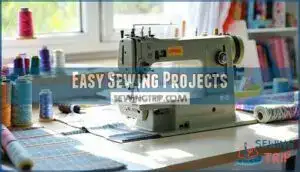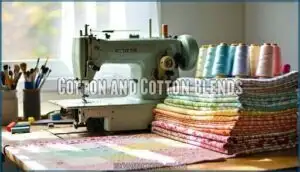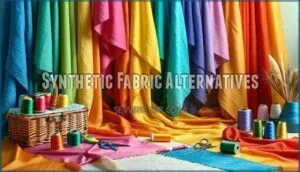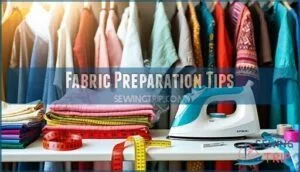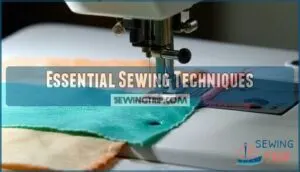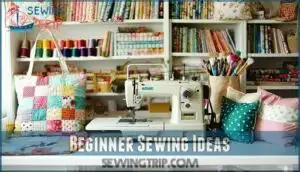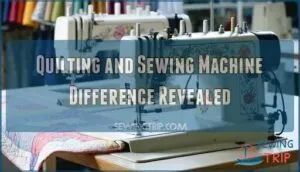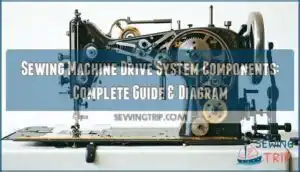This site is supported by our readers. We may earn a commission, at no cost to you, if you purchase through links.
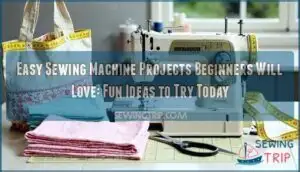 You’ll love these easy sewing machine projects beginners can finish in an afternoon: zippered pouches, pillowcases, tote bags, and simple placemats.
You’ll love these easy sewing machine projects beginners can finish in an afternoon: zippered pouches, pillowcases, tote bags, and simple placemats.
Start with straight seams and basic cotton fabrics—they’re forgiving when you’re still getting your feet wet with threading and tension.
Think of your first projects like training wheels; they build confidence before tackling trickier techniques.
Don’t worry about perfection—even experienced sewists sometimes end up with wonky stitches! Focus on mastering consistent seam allowances and proper pinning techniques.
The satisfaction of creating something useful with your own hands makes those initial learning curves totally worth overcoming.
Table Of Contents
Key Takeaways
- Start with simple projects like pillowcases, tote bags, or fabric coasters to build confidence and master basic techniques.
- Use cotton fabrics for beginner projects—they’re easy to handle, durable, and forgiving with mistakes.
- Practice sewing straight lines, proper pinning, and seam allowances on scraps before diving into larger projects.
- Always prep your fabric with pre-washing, ironing, and cutting along the grain for the best results.
Easy Sewing Projects
You’ll find these beginner-friendly sewing projects perfect for getting comfortable with your machine while creating something useful right away.
From simple pillowcases to quick tote bags, you’re about to turn those fabric scraps into finished projects that friends will think came from a store.
Beginner Friendly Patterns
Starting your sewing journey begins with the right patterns – ones that build confidence while teaching essential skills.
Here are four beginner-friendly patterns that won’t leave you tangled in frustration:
- Simple Pillowcases – straight seams that teach you fabric alignment basics
- Tote Bags – practical projects that you’ll actually use daily
- Easy Aprons – learn hemming while creating something functional
- Scarves – quick wins that boost your confidence
Don’t overlook simple cushion covers – they’re perfect for practicing corners.
Getting started requires suitable beginner sewing supplies.
Kids’ clothes patterns designed for beginners offer clear instructions with fewer pieces. Remember, everyone’s first project had wobbly seams!
Simple Fabric Crafts
After mastering basic patterns, you’ll find joy in transforming fabric scraps into charming creations!
Scrap fabric crafts let you experiment without the pressure of perfection.
Try making textile art projects like folded fabric coasters, which protect furniture while showcasing your favorite prints.
Add fabric embellishments with simple appliqué techniques—just cut shapes from colorful scraps and stitch them onto plain items for instant personality.
Seasonal fabric crafts make your home feel festive year-round with minimal effort.
Repurposed fabric ideas aren’t just budget-friendly; they’re eco-conscious too!
Remember, these easy sewing machine projects aren’t about flawlessness—they’re about releasing your creativity and having fun with your machine.
Each small success builds your confidence!
Quick Gift Ideas
After mastering simple fabric crafts, you’ll love making quick gifts on your sewing machine!
Need a last-minute present? Here are five handmade ideas anyone can create:
- Chapstick holders using colorful fabric scraps
- Personalized fabric coasters with monogrammed initials
- Small drawstring bags perfect for jewelry or treats
- Holiday-themed pillowcases (a gift that keeps giving!)
- Padded headbands that use up leftover fabric
These easy beginner sewing projects show your thoughtfulness without breaking the bank! Consider also that handmade gifts show care, adding a personal touch. Making handmade gifts is a great way to express your feelings.
Sewing Machine Basics
Now that you’ve got your project ideas, let’s talk about the machine that’ll bring them to life. Your sewing machine isn’t as scary as it might look!
First, meet your new friend properly. Take time to identify all the parts—the presser foot, feed dogs, and bobbin case are your allies in this journey.
| Task | Tip | Troubleshooting |
|---|---|---|
| Threading machine | Follow manual diagrams | Thread breaks? Rethread completely |
| Bobbin winding | Keep tension even | Wobbly bobbin? Check placement |
| Stitch selection | Start with straight stitch | Skipped stitches? Change needle |
Practice tension adjustment on scraps before diving into projects. Different needle types matter—universal for cotton, ballpoint for knits.
Remember when I first tried sewing? The thread bunched up underneath like a bird’s nest! Just clean lint from your bobbin area regularly and you’ll avoid that headache.
Ready for fabric fun? Let’s pick the right materials next.
Choosing Fabric Types
You’ll find that picking the right fabric makes all the difference between a smooth sewing adventure and a frustrating fabric fight.
Cotton and cotton blends are your best friends when you’re starting out, giving you that perfect balance of easy handling and forgiving mistakes, making the experience more enjoyable with the right choice of fabric.
Cotton fabrics are beginner-friendly heroes—easy to handle, forgiving mistakes, and perfect for building sewing confidence.
Cotton and Cotton Blends
Now that you’ve got to know your machine, let’s talk fabric. Cotton and cotton blends are your best friends when learning to sew! They stay put while cutting and don’t slide around under your presser foot.
- Cotton fabrics come in different weights – lighter for summer clothes, heavier for tote bags
- Blend benefits include less wrinkling and added stretch for comfy projects
- Print options range from subtle solids to fun patterns perfect for pillowcases
Cotton’s durability means your beginner sewing projects will last. Many crafters enjoy the benefits of versatile blended materials for their projects. The fabric forgives mistakes and presses beautifully – exactly what you need for easy sewing success!
Synthetic Fabric Alternatives
Beyond cotton, your sewing journey can embrace eco-friendly alternatives too! Natural fibers like bamboo offer incredible softness while being super easy to work with—perfect for beginner sewing projects.
You’ll love innovative textiles like Piñatex (made from pineapple waste) or Mylo (mushroom leather) that combine sustainability with unique textures.
These plant-based fabrics aren’t just good for the planet; they’re wonderful for simple sewing projects too. Upcycled materials give your creations character while sustainable options like hemp and recycled polyester make your sewing machine projects both beautiful and responsible.
Fabric Preparation Tips
While synthetic fabrics offer versatility, proper fabric prep makes all the difference in your sewing journey.
Your fabric needs TLC before you start:
- Pre-washing fabrics prevents dreaded post-project shrinkage
- Ironing thoroughly removes wrinkles that can sabotage precision
- Cutting accurately along the fabric grain guarantees your project hangs correctly
Remember, a well-prepared fabric is half the battle won! For cohesive designs, consider color wheel guidance. Your sewing machine will thank you, and your beginner projects will look surprisingly professional.
Essential Sewing Techniques
You’ll master the basics faster than you can say "bobbin trouble" with these simple but essential sewing techniques that every beginner needs.
Once you’ve got these fundamental skills under your belt, you’ll tackle any project with confidence and have fun watching your creations come to life.
Seam Allowance Guidelines
Seam allowance is the secret sauce that turns wobbly projects into professional masterpieces.
Most patterns call for a standard 5/8" (1.5 cm) measurement between your fabric edge and stitching line.
| Seam Guide Type | Best For | Difficulty | Cost |
|---|---|---|---|
| Machine Guides | Beginners | Easy | Free |
| Masking Tape | Custom widths | Easy | Cheap |
| Seam Guide Tool | Precision work | Medium | Moderate |
| Elastic Bands | Quick fixes | Easy | Very cheap |
When pivoting corners, stop with your needle down, lift the presser foot, then rotate.
Always backstitch at the beginning and end of seams for durability.
Understanding thread weight importance guarantees the right choice for your fabric and project.
Remember: accurate seams mean proper pattern fitting!
Thread Control Methods
Many sewers struggle with thread control, but these simple tricks will make it easier. Start by holding your thread tails when beginning to sew—this prevents jamming and unthreading.
Adjust your thread tension to match your fabric; proper tension creates even stitches without puckering or breaking. Remember to backstitch at the beginning and end of seams to secure your work.
When winding your bobbin, keep it smooth and even for consistent stitching. For beginners, practicing speed control can prevent tangles.
Try running thread through beeswax or a dryer sheet to reduce knotting issues—it’s a game-changer for sewing basics!
Fabric Alignment Tips
Align your fabric perfectly with these simple techniques that make all the difference:
- Position fabric against needle plate guides or attach a seam guide for consistent seam allowances every time.
- Use your presser foot edge as a natural guide—it’s already there to help you maintain straight seams!
- Master pivot points by stopping with the needle down, lifting the presser foot, and rotating the fabric smoothly.
You’ll be sewing like a pro before you know it!
Beginner Sewing Ideas
You’ll find these beginner sewing ideas perfect for getting comfortable with your machine while creating something useful right away.
Beginner sewing projects let you create something useful fast, building confidence and sparking creativity with every stitch.
From simple pillowcases to quick drawstring bags, you’ll be amazed at what you can make in just an afternoon without getting your thread in a tangle.
You’ll be creating something useful right away, which is a great motivator to continue learning and improving your sewing skills.
Home Decor Projects
Now that you’ve mastered basic techniques, let’s transform your living space with simple home decor projects that won’t overwhelm you.
| Project Type | Difficulty | Completion Time |
|---|---|---|
| Table Runners | ★☆☆ | 1-2 hours |
| Fabric Coasters | ★☆☆ | 30 minutes |
| Placemat Sets | ★★☆ | 1-3 hours |
You’ll love creating potholder designs and holiday decor pieces that showcase your new skills. Consider making envelope pillowcases for a quick decor refresh. These easy sewing projects for beginners add personality to your home without breaking the bank.
Clothing and Accessories
After creating cozy home decor, why not dress yourself (or your pets) in handmade style? Clothing and accessories are perfect for beginner sewers.
You’ll love these easy starter projects:
- Transform old jeans into appliqué letters for plain sweatshirts using upcycled denim
- Add colorful pocket tees to your wardrobe with simple stitching techniques
- Create comfy wool cases for your devices that don’t require finished seams
Kids’ leggings with elastic waistbands and cute pet bandanas are quick wins too. T-shirt dresses are another beginner-friendly project that’ll have you looking stylish in no time! Many resources are available for beginner sewing projects.
Eco Friendly Sewing Options
Why not transform your beginner sewing journey into an eco-conscious adventure?
Start with zero waste sewing projects like reusable shopping bags or dish sponges using organic fabrics. You’ll save money while saving the planet!
Upcycled materials like old t-shirts or jeans make perfect practice pieces for easy sewing projects. Try natural dyes on cotton scraps for colorful coasters, or use sustainable threads for produce bags.
Your new hobby isn’t just building skills—it’s creating purposeful items that reduce waste. Small stitches today make a greener tomorrow!
Frequently Asked Questions (FAQs)
What is the easiest thing to sew for a beginner?
You’ll find pillowcases, drawstring bags, and fabric coasters are your best bets.
They require just straight stitches, minimal cutting, and you’ll finish quickly.
Perfect for building confidence while creating something useful!
What can I sew in 30 minutes?
As quick as a flash, you can whip up fabric coasters, drawstring bags, pillowcases, wristlet keychain fobs, or simple tote bags in 30 minutes.
Pincushions and headbands are perfect speedy projects too!
What is the easiest fabric to sew for beginners?
Cotton fabrics, especially 100% cotton or cotton blends, are the easiest to sew.
They’re sturdy, don’t stretch much, and hold their shape well.
Plus, they won’t slip around like silk or stretchy materials, which makes them a great choice because they are sturdy.
What is the first thing you should learn to sew?
Start with sewing straight lines on fabric scraps.
It’s like learning to ride a bike—wobbly at first, but practice makes perfect.
Straight lines teach control, build confidence, and set the foundation for future projects.
What can I make easy with a sewing machine?
Did you know 60% of sewing beginners stick with it by starting easy?
They try projects like pillowcases, drawstring bags, or fabric coasters.
These projects are simple, practical, and perfect for mastering straight stitches while boosting your confidence!
How do I fix uneven stitches easily?
Check your thread tension and rethread the machine, ensuring the bobbin and spool are correctly placed.
Use quality thread, clean the feed dogs, and practice sewing slower—it’s like driving; control matters!
What’s the best needle size for beginners?
Think of your needle as the unsung hero of your sewing journey.
For beginners, a universal size 80/12 needle works best.
It handles most fabrics, keeps things simple, and avoids unnecessary frustration.
How can I prevent fabric from puckering?
To prevent puckering, use the correct needle and thread for your fabric, lower the tension slightly, and make certain of even feeding by holding fabric taut but not stretched.
Practice on scraps first—it’s a lifesaver!
How do I maintain a sewing machine properly?
A well-maintained sewing machine can last decades—think of it as a trusty car.
Clean lint regularly, oil moving parts (check your manual), and change needles often.
Treat it kindly, and it’ll hum happily!
What tools enhance precision in sewing projects?
Use tools like seam guides, masking tape, or elastic bands to keep stitches straight.
A clear ruler helps with precise measurements, while sharp scissors and a seam ripper guarantee clean cuts and easy fixes.
Conclusion
Funny how "easy sewing machine projects beginners" can start with tangled thread, right?
But now you’ve got the basics—measuring seam allowances, pinning like a pro, and taming those straight stitches.
Keep practicing, and soon zippered pouches and pillowcases will feel like second nature.
Remember, it’s not about flawless finishes; it’s about improving with each project.
So grab some fabric, fire up that sewing machine, and enjoy crafting creations uniquely yours, building confidence stitch by stitch!
- https://www.youtube.com/channel/UCs5ac28qTOHHDOlwbyRg-CQ
- https://ohsolovelyvintage.blogspot.com/2012/02/diy-ipad-case.html
- http://www.madeeveryday.com/2015/10/new-video-how-to-sew-a-circle-skirt.html/
- https://www.allpeoplequilt.com/bags-pillows-gifts/pincushions/easiest-pincushion-ever
- https://mellysews.com/beginner-sewing-project-drawstring-bag/

